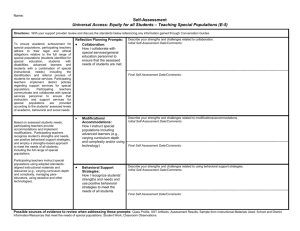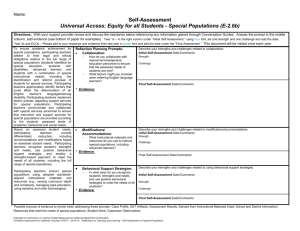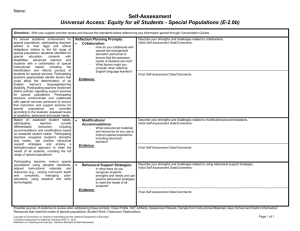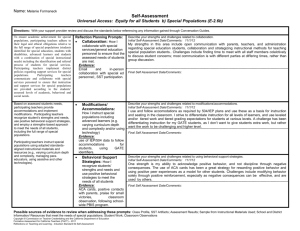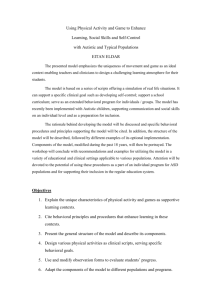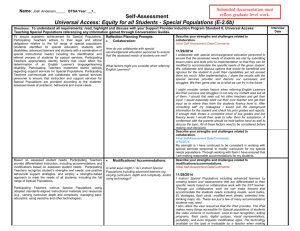Self-Assessment Universal Access Teaching Special Populations
advertisement
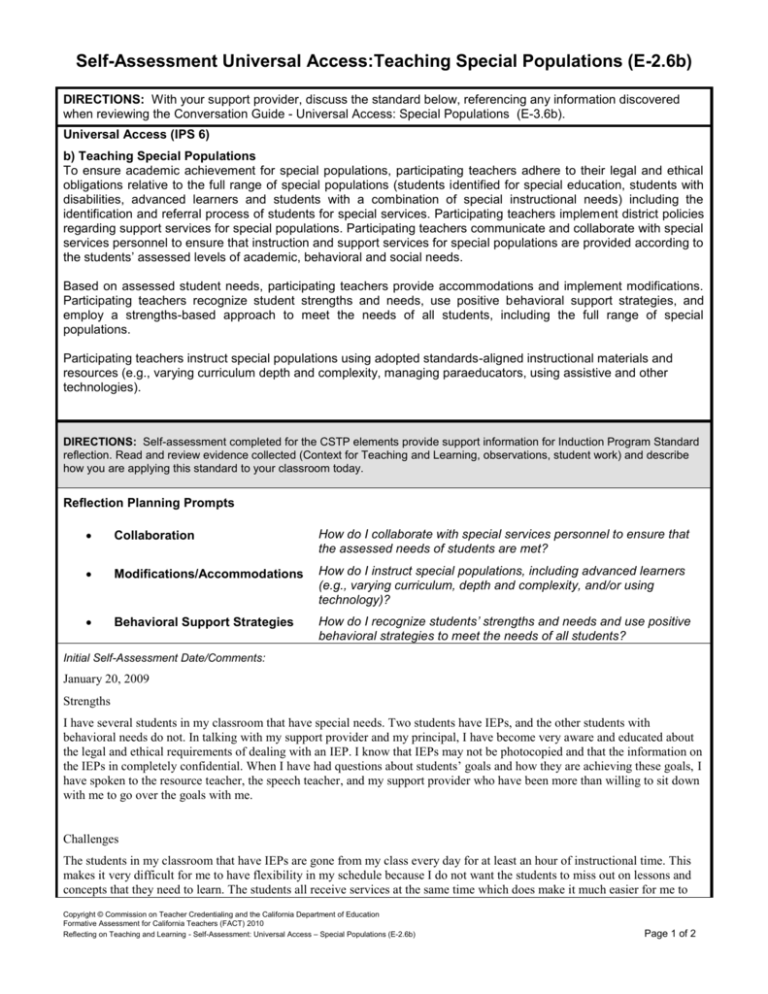
Self-Assessment Universal Access:Teaching Special Populations (E-2.6b) DIRECTIONS: With your support provider, discuss the standard below, referencing any information discovered when reviewing the Conversation Guide - Universal Access: Special Populations (E-3.6b). Universal Access (IPS 6) b) Teaching Special Populations To ensure academic achievement for special populations, participating teachers adhere to their legal and ethical obligations relative to the full range of special populations (students identified for special education, students with disabilities, advanced learners and students with a combination of special instructional needs) including the identification and referral process of students for special services. Participating teachers implement district policies regarding support services for special populations. Participating teachers communicate and collaborate with special services personnel to ensure that instruction and support services for special populations are provided according to the students’ assessed levels of academic, behavioral and social needs. Based on assessed student needs, participating teachers provide accommodations and implement modifications. Participating teachers recognize student strengths and needs, use positive behavioral support strategies, and employ a strengths-based approach to meet the needs of all students, including the full range of special populations. Participating teachers instruct special populations using adopted standards-aligned instructional materials and resources (e.g., varying curriculum depth and complexity, managing paraeducators, using assistive and other technologies). DIRECTIONS: Self-assessment completed for the CSTP elements provide support information for Induction Program Standard reflection. Read and review evidence collected (Context for Teaching and Learning, observations, student work) and describe how you are applying this standard to your classroom today. Reflection Planning Prompts Collaboration How do I collaborate with special services personnel to ensure that the assessed needs of students are met? Modifications/Accommodations How do I instruct special populations, including advanced learners (e.g., varying curriculum, depth and complexity, and/or using technology)? Behavioral Support Strategies How do I recognize students’ strengths and needs and use positive behavioral strategies to meet the needs of all students? Initial Self-Assessment Date/Comments: January 20, 2009 Strengths I have several students in my classroom that have special needs. Two students have IEPs, and the other students with behavioral needs do not. In talking with my support provider and my principal, I have become very aware and educated about the legal and ethical requirements of dealing with an IEP. I know that IEPs may not be photocopied and that the information on the IEPs in completely confidential. When I have had questions about students’ goals and how they are achieving these goals, I have spoken to the resource teacher, the speech teacher, and my support provider who have been more than willing to sit down with me to go over the goals with me. Challenges The students in my classroom that have IEPs are gone from my class every day for at least an hour of instructional time. This makes it very difficult for me to have flexibility in my schedule because I do not want the students to miss out on lessons and concepts that they need to learn. The students all receive services at the same time which does make it much easier for me to Copyright © Commission on Teacher Credentialing and the California Department of Education Formative Assessment for California Teachers (FACT) 2010 Reflecting on Teaching and Learning - Self-Assessment: Universal Access – Special Populations (E-2.6b) Page 1 of 2 plan accordingly, however, when things arise such as assemblies and other unforeseen events, it does make it a little harder to rearrange my schedule. The students are working towards different goals than most of the other students in my classroom and therefore do modified or different assignments. Most of the students in my class are very accepting of these students; however, there are times when a student in my class will notice that a few students are doing a different assignment and they will make comments as to why they are doing something different. I am working with building self-confidence with my students with IEPs because I know there are times when they feel different, and I want to make sure that they don’t feel badly about themselves because of their abilities. Application in the Classroom I talk with the resource and speech teacher often to check in on the progress of my students that receive services from them. This helps me gauge and understand how I can better align the work that they complete in my classroom. I send work to the resource teacher so that the students can receive even more one-on-one assistance from her. I also work with these students in a small group setting and one-on-one so that I make sure to meet the needs of my students and meet the goals that are listed on their IEPs. I read one-on-one with theses students working on their comprehension and fluency because they are in need of reading assistance. The students are able to work with their peers in partner and group settings so that they also can get the social interaction of working with classmates since they are gone out of my classroom for a big part of the day. Revisit Date(s)/Comments: Final Self Assessment Date/Comments: Copyright © Commission on Teacher Credentialing and the California Department of Education Formative Assessment for California Teachers (FACT) 2010 Reflecting on Teaching and Learning - Self-Assessment: Universal Access – Special Populations (E-2.6b) Page 2 of 2
